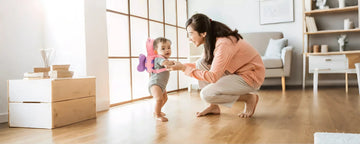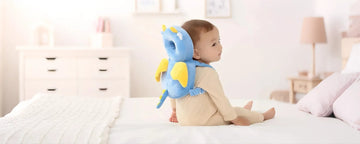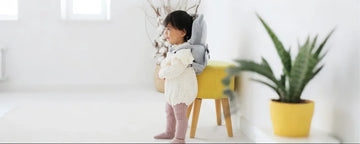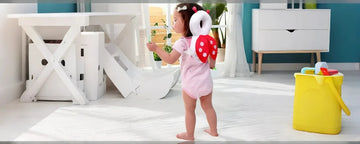Watching a toddler take their first steps is one of the most exciting milestones for any parent. That little, wobbly walk, the unsteady balance, and the determination in their eyes are moments to cherish. But those first steps also come with an inevitable risk: falls. Understanding why toddlers fall, how their bodies react to impacts, and what safety measures can help is crucial to keeping your child safe.
In this guide, we delve into the science behind toddler falls and explain how you can use practical solutions, including toddler head protection, to reduce the risk of injury while encouraging safe exploration.
Why Toddlers Fall: A Developmental Perspective
Toddlers are natural explorers, and their falls are a normal part of learning. Between 9 and 24 months, children transition from crawling to standing, walking, and eventually running. This period is crucial for developing motor skills, coordination, and muscle strength. However, several biological and physiological factors make toddlers prone to falls:
- Top-heavy body structure: A toddler’s head is proportionally larger compared to the rest of their body. This top-heavy structure shifts their center of gravity forward, backward, or sideways, making balance more difficult.
- Immature motor skills: Early walking involves trial and error. Muscles, reflexes, and coordination are still developing, so toddlers often step over, trip, or misjudge distances.
- Limited protective reflexes: Adults instinctively use their arms and hands to break a fall. Toddlers’ reflexes are not fully developed, so they often fall directly onto their back, head, or side.
- High Curiosity: Toddlers are driven by curiosity. They explore stairs, furniture, and uneven surfaces without fully understanding the dangers. Their eagerness to explore increases the likelihood of falls.
Understanding these factors helps parents anticipate risks and take protective measures before injuries occur.
The mechanics of a toddler's fall
When a toddler falls, the body is affected by multiple forces. The severity of the injury depends on:
- Fall height: Even a short fall can cause bumps or bruises, but higher falls increase the risk of serious injury.
- Surface type: Hard surfaces like tile or concrete increase the risk of head or skeletal injuries compared to carpet or upholstered floors.
- Direction of fall: Backward or sideways falls are particularly risky for head injuries because young children are often unable to protect themselves effectively.
- Shock absorption: Clothing or protective gear can help absorb some of the force and reduce the likelihood of serious injury.
This mechanism explains why a soft, padded layer like a toddler head protector is so effective—it acts as a shock absorber for the most vulnerable areas in a fall.
Understanding Head Injuries in Toddlers
Head injuries are the most concerning type of fall-related injury for toddlers. While many impacts are minor, serious head injuries can have lasting consequences. Common types of injuries include:
- Bruises on the scalp: Usually harmless and heal quickly.
- Concussions: Mild concussions may cause temporary dizziness or irritability; severe cases require medical attention.
- Skull fractures: Rare but serious, usually from falls from great heights or hard surfaces.
- Soft tissue injuries: Swelling and tenderness around the scalp or neck.
Preventive measures such as padded surfaces, supervision and protective equipment help to minimise these risks. Head protection specifically targets the area most vulnerable to a backward fall – the back of the head – while allowing toddlers to move naturally.
How toddler head protection works
A toddler head protection is a simple yet highly effective safety solution. It is worn like a small backpack and covers the back of the head and upper spine. Key benefits include:
- Shock absorption: High-elastic PP cotton padding and plush fabric cushion the head in the event of a backward or sideways fall.
- Comfortable design: Lightweight, breathable materials prevent discomfort, so toddlers can wear them for extended periods.
- Adjustable fit: Shoulder and chest straps ensure the protector fits securely without slipping, accommodating different sizes and growth stages.
- Engaging appearance: Playful designs such as butterflies, turtles, dinosaurs and penguins encourage toddlers to wear the cover voluntarily.
Unlike helmets, which can feel bulky or restrictive, headgear allows toddlers to crawl, walk, and play naturally while providing a practical layer of defense.
Other Safety Measures That Complement Headgear
While headgear is important, combining it with other safety measures ensures comprehensive protection:
- Supervised Play: Always keep an eye on toddlers, especially near stairs, furniture, or uneven surfaces.
- Soft Play Areas: Use padded mats or blankets in play areas to reduce the impact of falls.
- Baby Gates: Block access to dangerous areas like stairs or kitchens.
- Childproof Furniture: Install corner guards and secure heavy furniture to walls to prevent it from tipping over.
- Safe Shoes: Non-slip socks or shoes help toddlers maintain balance and reduce the risk of slipping.
By combining these precautions with a head protection pillow, parents create a safer environment without restricting their toddler's natural exploration and curiosity.
Encourage Safe Exploration
It’s important to remember that falls are a normal part of development. Trying to eliminate all risk can hinder learning and independence. The goal is to manage risk, not eliminate it.
- Let toddlers explore under supervision: Allowing movement encourages motor skill development.
- Praise effort, not perfection: Focus on milestones rather than avoiding every trip.
- Use safety equipment consistently: Make safety measures, like wearing a head protector, a habit from the start.
- Train gradually: Teach toddlers to hold onto handrails or avoid slippery areas as they grow.
This balanced approach ensures that children develop confidence, coordination, and resilience while staying protected.
Real-world effects of head protectors
Many parents have shared stories of how toddler headrests saved their little ones from serious bumps and bruises. Whether it’s a toddler stumbling down a hallway, tipping off a small chair, or falling during playtime, the padded cushion reduces both the severity of the impact and the fear associated with falls.
The Cubbora Toddler Headrest, with its soft plush exterior, breathable fabric, and adjustable straps, has become a trusted tool for parents looking for a simple, effective, and kid-friendly solution. It’s more than safety gear—it’s a confidence booster for both toddlers and parents.
Conclusion
Falls are an inevitable part of toddlerhood, but injuries don’t have to be. Understanding the science behind toddler falls—from body structure to reflexes—helps parents anticipate risks and take effective preventative measures.
A toddler head protector is a practical, comfortable and fun solution that protects the most vulnerable area in the event of a fall, allowing toddlers to explore safely. Combined with supervised play, soft surfaces, child gates and other child-safe measures, parents can create a safer environment that encourages learning, independence and confidence.
At Cubbora, we designed our toddler head protector to address real-world risks while keeping comfort and style in mind. By equipping toddlers with the right protection and giving them the freedom to explore, parents can enjoy peace of mind, and toddlers can safely embrace the excitement of their first steps.
Cubbora— Protecting every step.





